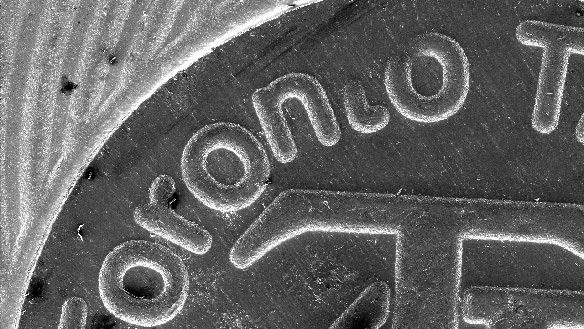Professor Zhirui Wang aids CBC News in examining fake TTC tokens

Photo: an electron microscope scan of a fake TTC token shows the letter “t” is incomplete (University of Toronto)
November 21, 2010
A sophisticated counterfeit TTC token obtained by CBC News underscores the challenges faced by the Toronto transit agency as it tries to deal with a problem that is costing it hundreds of thousands of dollars every year.
The token, at first glance, looks virtually identical to a regular Toronto Transit Commission (TTC) token. The two even weigh the same. But a closer examination carried out by the University of Toronto’s Department of Materials Science & Engineering yesterday revealed a number of differences.
A look through an electron microscope revealed:
- the top of the second “t” in Toronto appeared to be cut off
- the ridges found on the outside edges of the fake token aren’t as clearly defined as those on real ones
- the spacing of the letters is not consistent

Professor Zhirui Wang (MSE), who oversaw the analysis, said the inaccuracies in the lettering and the scratches were probably due to an inferior die used by the counterfeiter.
Professor Wang’s team, including engineering technologist Sal Boccia and PhD candidate Charles Kwan, was also able to determine the composition of the fake token and found that nickel, which is used in the real token to ensure durability, was virtually absent in the fake. Nickel is generally more expensive than metals like zinc or copper, found in abundance in the fake version.
Professor Wang estimates it may have cost up to $100,000 to produce these tokens, so counterfeiters would have to sell a lot to make a profit.
| Material | Real token (% weight: inner core) |
Counterfeit token (% weight: inner core) |
||
| Copper | 73.19 | 62.60 | ||
| Zinc | 23.09 | 36.27 | ||
| Nickel | 2.36 | 0.31 | ||
| Silicon | 0.24 | 0.10 | ||
| Aluminum | 1.18 | 0.72 | ||
| Real token (% weight: outer ring) |
Counterfeit token (% weight: outer ring) |
|||
| Aluminum | 95.65 | 97.86 | ||
| Silicon | 1.12 | 0.95 | ||
| Magnesium | 2.90 | 0.87 | ||
| Copper | 0.33 | 0.33 |
Source: University of Toronto Department of Materials Science & Engineering
— With files from CBC News (November 21, 2010)